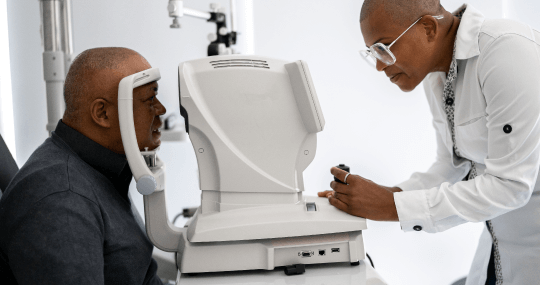No matter your age, it is important to protect your eyes and preserve your vision.
Cataracts are the leading cause of vision loss in the U.S. When proteins in the eye’s natural lens clump together and cloud the lens, this cloudy or blurry spot is called a cataract.
Cataract Awareness Month is celebrated in June to focus on this common eye condition that affects more than 24 million Americans.
Eye conditions share risk factors
Cataracts and glaucoma may occur at the same time in a patient’s eyes. Learning facts about both conditions and seeking treatment early may prevent vision loss.
Like cataracts, glaucoma can lead to blindness through damage to the optic nerve. About three million people in the U.S. have this disease.
Generally, both eye conditions are unrelated. According to the National Eye Institute, however, cataracts can increase elevated eye pressure risk, possibly leading to glaucoma. Similarly, some treatments for glaucoma may make cataracts worse or quicken their formation, according to Glaucoma UK.
Both eye conditions typically occur in adults older than 55 and often in people with a family history. Some medications, past eye injuries or certain medical conditions can increase the risk of developing both.
Lifestyle factors that increase your risk of cataracts include the following:
- Excessive exposure to sunlight
- Smoking
- Obesity
- High blood pressure
- Prolonged use of corticosteroid medications
- Drinking excessive amounts of alcohol
Risk factors for glaucoma include the following:
- African-American heritage
- History of steroid use, either in the eye (drops) or systemically (orally or injected)
- Nearsighted (myopic)
- Farsighted (hyperopic)
- History of elevated intraocular pressure
Symptoms and treatments vary
While cataracts and glaucoma both negatively affect one’s vision, the symptoms and treatments vary for each.
Symptoms of cataracts may not be visible at first, but eventually, you may notice your vision has become cloudy or blurry. You may also have difficulty seeing at night, especially while driving. You may see halos around lights, faded or yellow colors or even experience double vision.
When cataracts start affecting your lifestyle, they are treatable with a simple surgical procedure, which has approximately a 98 percent success rate.
In its early stages, glaucoma often has no symptoms. Elevated pressure inside the eye creates stress on the optic nerve, and if it is damaged, vision loss occurs.
Early detection is critical for glaucoma because there is no cure for the disease. Treatments include medicated eye drops, laser surgery or conventional glaucoma surgery.
New developments in Micro-Invasive Glaucoma Surgery (MIGS) allow patients to undergo treatment for both glaucoma and cataracts during one procedure. The surgery is safe and effective in helping treat primary open-angle glaucoma and cataracts.
Don’t delay your diagnosis!
The U.S. Centers for Disease Control and Prevention (CDC) estimates about 39 million Americans will have cataracts by 2032.
Glaucoma is expected to affect more than four million Americans by 2030, according to the Glaucoma Research Foundation.
At least 75 percent of disease-related vision loss can be avoided through prevention or treatment. If you are at risk, you should schedule a comprehensive exam offered by an ophthalmologist. During an exam, your doctor looks at both your eye health as well as your vision.
Doctors recommend regular eye exams beginning at age 40 or earlier if you have disease risk factors, including family history, diabetes and high blood pressure. Don’t delay your diagnosis; schedule an exam with an eye care professional at a center near you.
